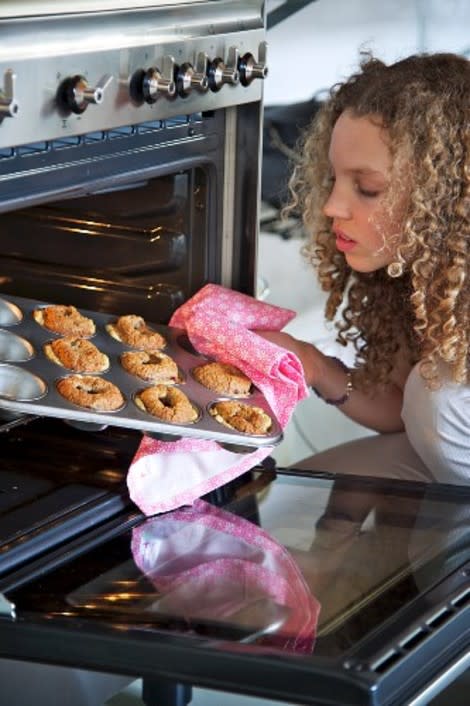12 Tips for Teaching Teens to Cook Healthy Food for Themselves
By Diana Van Buren
Teens need cooking inspiration somewhere. The popularity and abundance of television cooking shows does not appear to have encouraged the many Americans who watch them to return to the kitchen to cook a family meal. Unless, that is, you consider "cooking" to be using a countertop appliance that has a fool-proof "chicken nugget" button.
RELATED: Kid-friendly fruit muffins made from leftovers.
This next generation must learn how to cook for themselves, using whole foods - not just boxes and jars from Trader Joe's. Home cooking, starting with real whole foods, is empowering. And it is our only hope for reversing our national weight-gain and its rampant side effects, which show up in the form of mostly preventable, but ultimately debilitating, diseases.
RELATED: Feed your kids like the chefs feed theirs.
Where are the home economics classes of yore, where some of you may remember learning how to make an omelet? Not where we need them most, that's for sure.
From my limited research, home ec classes appear to exist in rural areas, where fast food is less ubiquitous - and hence, less damaging - than it is in urban and suburban parts of the country.
RELATED: Secrets to the perfect brown bag school lunch.
Cooking classes in high schools now appear to fall primarily within the realm of "Culinary Arts" programs for students who are considering entering the hospitality industry, sending the message, once again, that raw ingredients are to be transformed into meals only by professionals, not by families at home, in their own kitchens.
Leading by cooking
If teens aren't learning to cook at home, and they're not teaching it at school, then, where? I'll tell you where they could be learning.
Anyplace you can find a stove and a kitchen big enough to accommodate a bunch of people with knives, that's where. Churches are a good place to start. A restaurant that is closed one day a week, where the chef or owner is sympathetic to the cause. In the cafeteria kitchen, perhaps, at the end of the school day?
For two years, I taught cooking to teenagers at program sponsored by the Brooklyn College Community Partnership in Flatbush, Brooklyn. We used a 1950s-era home ec classroom for our after-school, drop-in program. Sure, we had numerous challenges, the hardest being that we never knew how many students were going to show up for this optional program. They came if they wanted to, and, in the beginning, at whatever time they wanted to. Planning and purchasing was difficult, but, with time and experience, we figured it out.
Cooking is a critical life skill, and it is the responsibility of those of us who know how to cook to share. And more than the skills and recipes. Irma Rombauer knew what she was talking about: We need to share the joy of cooking.
Making the kid-to-kitchen connection
Find sponsors. Get your local supermarket, a church, school, cooking supply store, library, a restaurant where you are a regular customer to sign on.
Recruit. Get those who like to cook (and who do it regularly) to teach a class or two. Others might be willing to help clean up, shop or donate equipment or ingredients.
Target teens. They need cooking skills the most. Reach out to them via peers, teachers, coaches, guidance counselors, after-school programs, Twitter and Facebook. Find a space that is easy for teenagers to get to after school or on weekends.
Set the bait. Near a basketball court or baseball field, set out a variety of locally grown apples or tomatoes, citrus or melons, some cut up, some whole. Let the kids come to you. In exchange for an apple or a slice of melon, ask them to write down their opinions and ratings, along with an email address.
Use real kitchen tools. Yes, including chef's knives. Have plenty of adults around to teach teens how to use these tools properly.
Bake something first. Coconut macaroons are easy, and inexpensive. Make a fruit and oats-based bar cookie, or apple crisp. Hand out copies of the recipes at the end of the class.
Try soup. Vegetable-based. No meat necessary. Butternut squash with apples is a crowd-pleaser. Tomato. Carrot-ginger.
Work magic. Transform simple ingredients into something special. Steamed asparagus is one thing. Buckwheat crepes wrapped around roasted asparagus spears is something else entirely. Chickpeas tossed with salad greens is a healthy lunch, but making hummus in a food processor is a lot more exciting. Fresh pineapple is delicious; broiled pineapple is even better.
Ignore food fears. Some kids will tell you, "I'm allergic to vegetables." Don't listen to them. They'll eat practically anything if they're ravenous, and that's what usually happens around 4:30 every afternoon.
Conquer whole meals. As your classes grow, delegate more complicated recipes to regular students and let them teach others.
Don't say "vegetarian." But cook primarily vegetable dishes.
Drink up. Make your own beverages.
Set the table. Use real plates, utensils and napkins. Everyone should sit down to eat together, at the same time.
Share K.P. Everyone helps clean up.
Diana Van Buren began her culinary training at Patisserie Lanciani in New York City, and became the pastry chef and wine buyer at Cafe Luxembourg. She's also worked at Keens Chophouse, Ten Twenty Two and Bar Six, where she was the managing partner. She edited Christopher Idone's "The New Glorious American Food" and "The Little Big Book of Comfort Food." Most recently, she taught cooking to teenagers in Brooklyn at the Brooklyn College Art Lab.
Also fresh on Zester Daily:
Rye whiskey's making a comeback in trendy cocktails.
Beaujolais, Nouveau or not, is good drinking.

